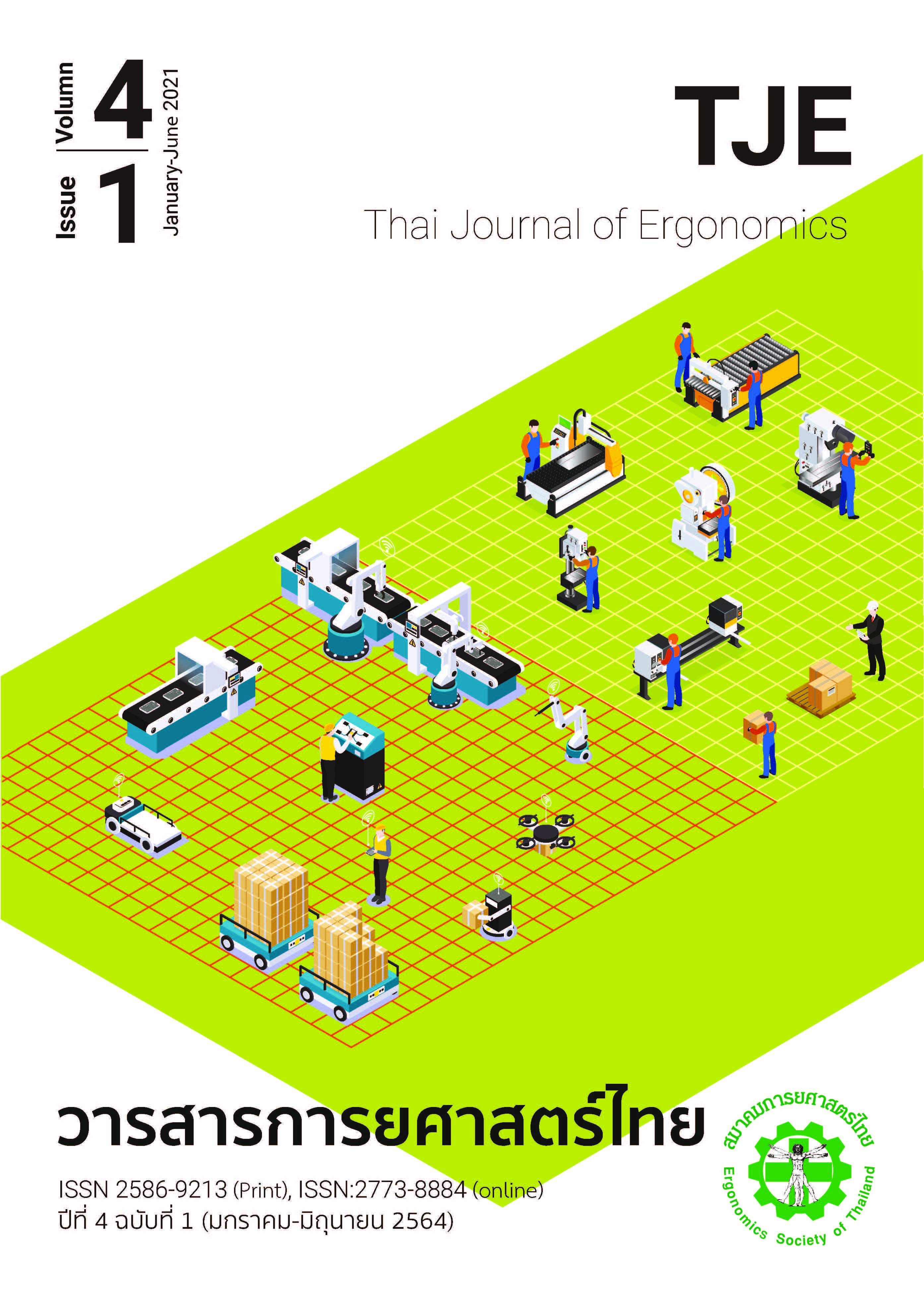Prevalence of and risk factors associated with work related musculoskeletal disorders among Benjarong’s ceramic informal labor in Samut-Sakorn, Thailand
Main Article Content
Abstract
ABSTRACT: Work-related musculoskeletal disorders (WMSDs) had highly reported in Thai informal labor, resulting in a chronic injury which impacted on productivity and quality reduction. This study aims to survey the prevalence of WMSDs in the past 12 months and 7 days in anatomical area with relationship of the individuals, work tasks and psychosocial factors. Twenty – seven labors who worked in coloring and lining task were recruited. They were measured individual factors, work-related factors by RULA for working posture, workstations (table and chair), psychosocial factors by SPST-20 for stress and surveyed the prevalence of WMSDs by modified Nordic Musculoskeletal questionnaire. Work-related factors showed working experiences were 21.07±12.61 years, working hours were 8.32±1.40 hours, resting from work hour were 1.46±0.72 hours and they were medium risk of working posture for 51.85%. In psychosocial factors, they were a low level of stress. The results revealed the top three prevalence in the late 12 months were lower back (37.04%), shoulder (25.93%) and knee (22.22%). In the late 7 days, the top three prevalence were lower back (37.04%) and shoulder (37.04%), wrist/hand (33.33%) and upper arm (25.93%), respectively.
Article Details
References
สำนักงานสถิติแห่งชาติ. สำรวจแรงงานนอกระบบ พ.ศ. 2560 [อินเทอร์เน็ต]. 2560. [เข้าถึงเมื่อ 19 ก.ย. 2562]. เข้าถึงได้จาก http://www.nso.go.th/sites/2014/DocLib13/ด้านสังคม /สาขาแรงงาน/Informal_work_force/แรงงานนอกระบบ_2560/แรงงานนอกระบบ_60.pdf
Stack T, Ostrom LT, Wilhelmsen CA. Occupational ergonomics: a practical approach. New Jersey: John Wiley & Sons; 2016.
Nunes IL, Bush PM. Work-related musculoskeletal disorders assessment and prevention. In Nunes IL, editor. Ergonomics-a systems approach. Croatia: InTech; 2012. p.1-31.
Barbe MF, Barr AE. Inflammation and the pathophysiology of work-related musculoskeletal disorders. Brain Behav Immun. 2006;20(5):423-9.
Sama W, Somtrakool K, Jantapho A. Benjarong sanitary ware: design and development for commerce in Samut Sakhon Province, Thailand. Asia Pac. J. Multidiscip. Res. 2015;3(3):59-64.
Songkham W, Chanprasit C, Jongrungrotsakul W, Kaewthummanukul T. Occupational and environmental health situation among ceramic workers: analysis in community and small enterprises. Nurs. J. 2018;45(4):97-110.
McAtamney L, Corlett EN. RULA: a survey method for the investigation of work-related upper limb disorders. Appl. Ergon. 1993 Apr 1;24(2):91-9.
Mahatnirunkul S, Pumpaisanchai W, Tarpunya P. Suanprung Stress Test-20, SPST-20. Bangkok: Department of Mental Health Ministry of Public Health; 2002.
Crawford JO. The Nordic musculoskeletal questionnaire. Occup. Med. 2007;57(4):300-1.
International Organization for Standardization. ISO 14738:2002 Safety of machinery: anthropometric requirements for the design of workstations at machinery. Geneva, Switzerland: The International Organization for Standardization; 2002.
Mannion AF, Dolan P. Electromyographic median frequency changes during isometric contraction of the back extensors to fatigue. Spine J. 1994;19(11):1223-9.
Sjøgaard G, Savard G, Juel C. Muscle blood flow during isometric activity and its relation to muscle fatigue. Eur. J. Appl. Physiol. Occup. Physiol. 1988;57(3):327-35.


